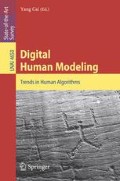Abstract
Most engineering software has been designed and optimized for parametric shapes. Sophisticated modeling of natural objects is free-form based, reflecting their inherent design. The merging of natural with parametric-based forms presents additional challenges. While work is needed, there are solutions that enable natural form modeling and analysis. Our focus is to use medical imaging and 3D modeling to analyze the natural form of human joint structure with specific application to joint replacement. The need for natural form modeling is also present in such other fields as varied as art, archeology and paleontology. In this chapter we illustrate examples of the breadth and power of natural form modeling.
Access this chapter
Tax calculation will be finalised at checkout
Purchases are for personal use only
Preview
Unable to display preview. Download preview PDF.
References
Robertson, D., Yamaguchi, K., Bigliani, L., Flatow, E.: Three dimensional analysis of the proximal humerus: relevance to arthroplasty. J Bone Joint Surg. 82-A, 1594–1602 (2000)
Robertson, D., Britton, C., Latona, C., Armfield, D.P.W., Maloney, W.: Hip biomechanics: importance to functional imaging. Semin Musculoskelet Rad. 7(1), 27–42 (2003)
Sharma, G., Robertson, D., Rodosky, M., McMahon, P.: Glenoid Structural Analyses: Relevance to Arthroplasty. In: Orthopaedic Research Society, Chicago, IL (2006)
Bimber, O., Gatesy, S.M., Witmer, L.M., Raskar, R., Encarnacao, L.: Merging fossil specimens with computer-generated information. Computer, 25–30 September (2002)
Delalieux, H., Tsuji, K., Wagatsuma, K., Van Grieken, R.: Material analysis methods applied to the study of ancient monuments, works of art and artefacts. Mater Trans. 43, 2197–2200 (2002)
Leitao, H.C.d.G.: Digitization and reconstruction of archaeological artifacts. IEEE 2001, 382 (2001)
Weber, G.W., Schafer, K., Prossinger, H., Gunz, P., Mitterocker, P., Seidler, H.: Virtual anthropology: the digital evolution in anthropological sciences. J. Physiol. Anthropol. Appl. Human Sci. 20, 69–80 (2001)
Cesarani, F., Martina, M.C., Ferraris, A., Grilletto, R., Boano, R., Marochetti, E.F., et al.: Whole-body three-dimensional multidetector CT of 13 Egyptian human mummies. AJR Am. J. Roentgenol. 180, 597–606 (2003)
Martin, R.B.: Porosity and specific surface of bone. Crit. Rev. Biomed. Eng. 10, 179–222 (1984)
Boileau, P., Sinnerton, R.J., Chuinard, C., Walch, G.: Arthroplasty of the shoulder. J. Bone Joint Surg. Br. 88, 562–575 (2006)
Skirving, A.P.: Total shoulder arthroplasty – current problems and possible solutions. J. Orthop. Sci. 4, 42–53 (1999)
Torchia, M.E., Cofield, R.H., Settergren, C.R.: Total shoulder arthroplasty with the Neer prosthesis: long-term results. J. Shoulder Elbow Surg. 6, 495–505 (1997)
Beaupre, G.S., Orr, T.E., Carter, D.R.: An approach for time-dependent bone modeling and remodeling–theoretical development. J. Orthop. Res. 8, 651–661 (1990)
Jacobs, C.R., Levenston, M.E., Beaupre, G.S., Simo, J.C., Carter, D.R.: Numerical instabilities in bone remodeling simulations: the advantages of a node-based finite element approach. J. Biomech. 28, 449–459 (1995)
Weinans, H., Huiskes, R., van Rietbergen, B., Sumner, D.R., Turner, T.M., Galante, J.O.: Adaptive bone remodeling around bonded noncemented total hip arthroplasty: a comparison between animal experiments and computer simulation. J. Orthop. Res. 11, 500–513 (1993)
Sharma, G., Robertson, D., Smolinski, P., Gilbertson, L., Debski, R., McMahon, P.: Glenoid Bone Remodeling: Numerical Simultion and Validation. In: Orthopaedic Research Society, San Diego, CA (2007)
Author information
Authors and Affiliations
Editor information
Editors and Affiliations
Rights and permissions
Copyright information
© 2008 Springer-Verlag Berlin Heidelberg
About this chapter
Cite this chapter
Robertson, D.D., Sharma, G.B. (2008). Natural Form Modeling. In: Cai, Y. (eds) Digital Human Modeling. Lecture Notes in Computer Science(), vol 4650. Springer, Berlin, Heidelberg. https://doi.org/10.1007/978-3-540-89430-8_9
Download citation
DOI: https://doi.org/10.1007/978-3-540-89430-8_9
Publisher Name: Springer, Berlin, Heidelberg
Print ISBN: 978-3-540-89429-2
Online ISBN: 978-3-540-89430-8
eBook Packages: Computer ScienceComputer Science (R0)

